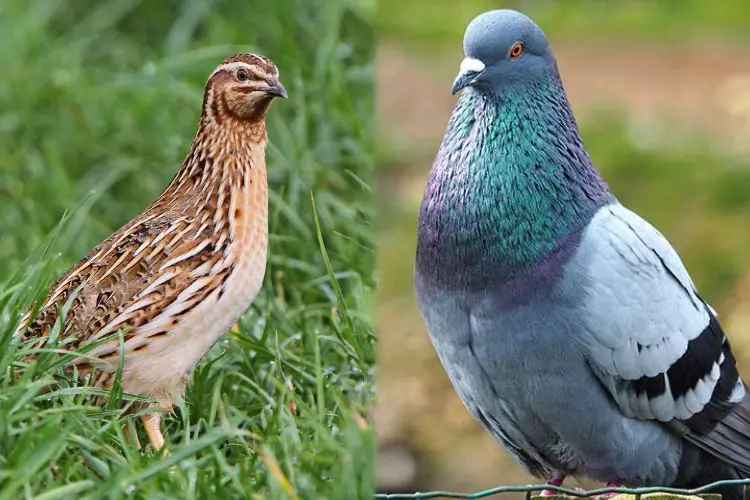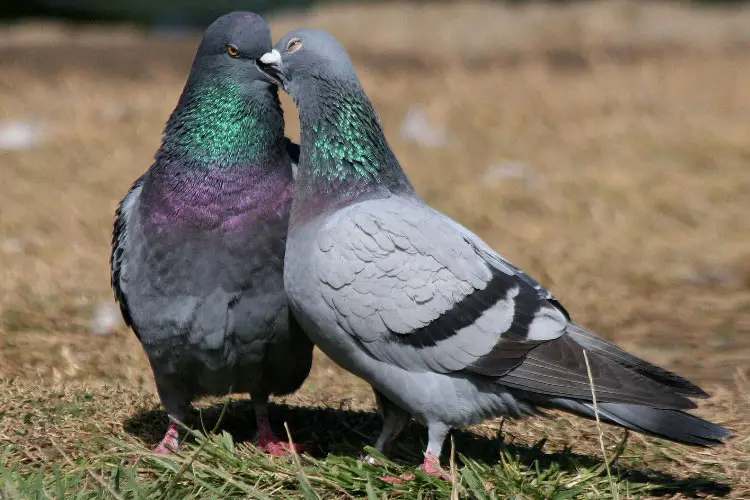Pigeon Training for Flying Competitions: Enhancing Speed, Agility, Precision
Have you ever marveled at the grace and precision of pigeons soaring through the sky? If you’re like me, you’ve probably wondered how these incredible birds are able to navigate and perform such breathtaking aerial displays. Well, the secret lies in the art of pigeon training for flying competitions. As a seasoned enthusiast and trainer myself, I’m here to share with you the ins and outs of this fascinating endeavor.
Pigeon training for flying competitions is not just about teaching these birds to fly, but rather about honing their natural instincts and abilities to achieve remarkable feats of flight. From precision racing to acrobatic displays, these competitions are a true testament to the incredible bond between pigeons and their trainers. Join me as we delve into the world of pigeon training, exploring the techniques, strategies, and dedication required to transform these humble birds into champions of the sky.
The Art of Pigeon Training for Flying Competitions
Pigeon training for flying competitions goes beyond simply teaching the birds how to fly. It’s a true art that involves honing their natural instincts and abilities to achieve remarkable feats of flight. In this section, I’ll explore the techniques, strategies, and dedication required to turn these birds into champions of the sky.
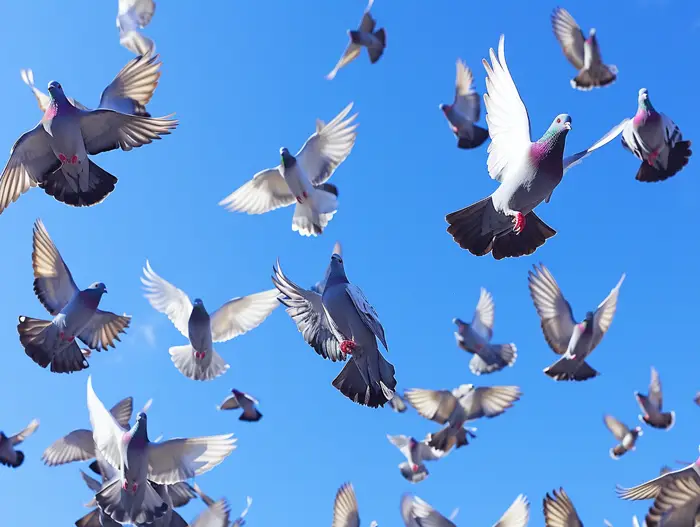
Building a Strong Foundation
Training pigeons for flying competitions starts with building a strong foundation. This involves selecting the right breed of pigeons that possess the necessary qualities for high-performance flying. Whether it’s speed, agility, or endurance, each breed has its unique strengths. As a trainer, I carefully select pigeons with the desired traits to ensure a strong foundation for training.
Instinctive Homing Abilities
One of the remarkable aspects of pigeon training is their instinctive homing abilities. Pigeons have an incredible sense of direction and can find their way back to their loft from long distances. By harnessing this innate instinct, trainers can enhance the pigeons’ homing abilities and improve their performance in flying competitions.
Training Techniques and Exercises
There are various training techniques and exercises used to enhance a pigeon’s flying skills. One common technique is free loft flying, where pigeons are allowed to fly freely around their loft to improve their endurance and navigation skills. Another technique is homing training, which involves gradually increasing the distance of pigeon flights to improve their homing capabilities.
Strategy and Racing Precision
In flying competitions, strategy plays a significant role in achieving success. Trainers meticulously plan the route and timing of the races, taking into consideration wind conditions, weather patterns, and the overall fitness of the pigeons. By strategically managing their pigeon’s flight patterns, trainers can maximize their chances of winning.
The Bond Between Trainer and Pigeon
Pigeon training is not just about teaching them to fly; it’s about developing a strong bond between the trainer and the birds. Regular interaction, care, and attention are essential in building trust and forming a deep understanding between the trainer and the pigeons. This close relationship is crucial in achieving optimal performance during competitions.
Understanding the Natural Instincts of Pigeons
Pigeons are fascinating creatures with remarkable natural instincts that make them ideal for flying competitions. Understanding their instincts is key to effective pigeon training. Let’s delve into some of these instincts:
- Homing Instinct: Pigeons have an incredible ability to find their way home from unfamiliar locations. This homing instinct is believed to be rooted in their excellent navigational skills, visual memory, and sensitivity to the Earth’s magnetic field. Did you know that pigeons can navigate using landmarks, the position of the sun, and even the Earth’s magnetic field?
- Flocking Behavior: Pigeons are social birds that have a strong need for companionship. They naturally form flocks, allowing them to share information about food sources, predators, and favorable roosting places. This flocking behavior also helps pigeons feel more secure and confident during flights.
- Orientation Skills: Pigeons are excellent at determining their geographical location. They use a combination of visual cues, smell, and the Earth’s magnetic field to orient themselves. Research has shown that pigeons can detect subtle changes in the Earth’s magnetic field and use this information to navigate accurately.
- Superior Vision: Pigeons have exceptional vision, which allows them to spot landmarks and navigate through challenging terrains. They have a wide field of vision, excellent depth perception, and the ability to see ultraviolet light. This keen eyesight is crucial for successful flights in various weather conditions.
By understanding and harnessing these natural instincts, trainers can optimize their pigeons’ performance in flying competitions. Training techniques that simulate real-life scenarios, such as free loft flying and homing exercises, capitalize on the pigeons’ innate abilities. Moreover, regular interaction, care, and attention from trainers help strengthen the bond between the pigeons and their handlers.
As I continue to explore the art of pigeon training for flying competitions, it becomes evident that tapping into these natural instincts is vital for success. The next section will focus on some advanced training techniques that further enhance pigeons’ flying abilities and prepare them for competitive flights.
Building a Bond: The Trainer-Pigeon Relationship
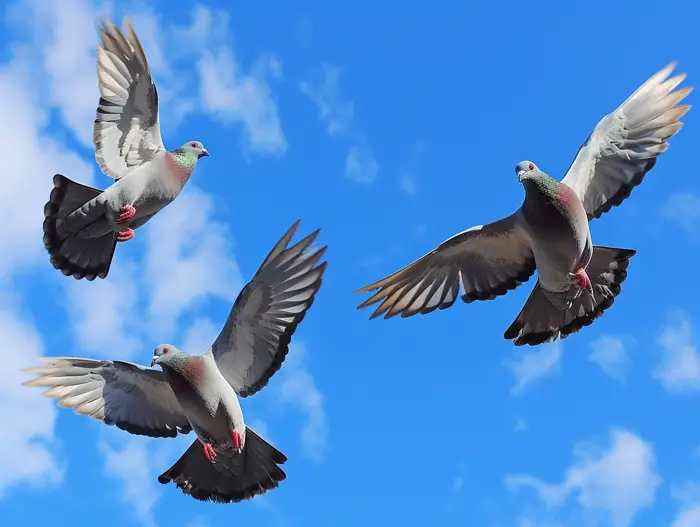
When it comes to pigeon training for flying competitions, building a strong bond between the trainer and the pigeons is crucial for success. Developing a close relationship based on trust and mutual understanding ensures that the pigeons are responsive and perform at their best. Here’s how trainers can establish and nurture this bond:
Regular Interaction: Interacting with the pigeons on a daily basis is essential to build trust and familiarity. Spending time with them in the loft, talking to them, and gently handling them helps create a positive association. This reinforces the bond and allows the pigeons to feel comfortable and secure in the presence of their trainer.
Care and Attention: Proper care and attention are vital in maintaining a healthy and happy flock. Trainers must ensure that the pigeons receive a nutritious diet, clean water, and a clean living environment. Regular health checks and prompt medical attention when needed are also important. By providing top-notch care, trainers show their pigeons that they are valued and cared for, strengthening the bond between them.
Positive Reinforcement: Just like any other animal, pigeons respond well to positive reinforcement. Rewarding desired behaviors with treats, verbal praise, or gentle petting helps reinforce the bond between the trainer and the pigeons. This encourages the pigeons to perform well and increases their eagerness to please their trainer.
Training Sessions: During training sessions, trainers can further strengthen the trainer-pigeon relationship. By using gentle and patient methods, they allow the pigeons to learn at their own pace. The trust and connection established through regular interaction and care contribute to a positive training experience for both the trainer and the pigeons.
Understanding Individual Pigeons: Pigeons, like humans, have unique personalities and preferences. It’s important for trainers to recognize and respect these differences. By taking the time to understand each pigeon’s temperament, trainers can tailor their training methods accordingly. This individualized approach fosters a deeper connection and enhances the training process.
The bond between trainers and pigeons is a crucial component of successful pigeon training for flying competitions. Through regular interaction, proper care, positive reinforcement, and understanding, trainers can establish a strong and trusting relationship with their pigeons, maximizing their chances of achieving optimal performance in the competitions.
Training Techniques for Enhancing Flight Skills
As a pigeon trainer, my goal is to help these birds reach their full potential in flying competitions. To enhance their flight skills, I employ various training techniques that are designed to build strength, agility, and endurance. Here are some effective strategies that I use:
- Free Flight Training: Giving pigeons the freedom to fly and explore the surroundings is crucial for developing their flight skills. I create a safe and secure environment where they can fly around freely, allowing them to build strength and navigate different flight patterns.
- Sprinting Exercises: Just like any athlete, pigeons need to build their speed and acceleration. I incorporate sprinting exercises into their training regimen, where they are encouraged to fly as fast as they can for short distances. This helps them improve their flight speed and reaction time.
- Obstacle Course Training: To enhance their agility and maneuverability, I set up obstacle courses for pigeons to navigate through. These courses include hoops, tunnels, and other challenging obstacles that require the birds to make quick turns and adjust their flight path. This helps them become more flexible and responsive in flight.
- Group Training Sessions: Pigeons are social creatures, and training in a group setting can be highly beneficial. During group training sessions, I release multiple pigeons together, encouraging them to fly in formation and learn from each other’s flight patterns. This helps them improve their flight coordination and adaptability.
- Visualization Techniques: Mental preparation is just as important as physical training. To enhance their focus and confidence, I use visualization techniques during training sessions. I create scenarios where the pigeons imagine themselves soaring through the sky with grace and precision. This helps them develop a strong mental connection with their flight abilities.
By incorporating these training techniques into my pigeons’ routine, I can help them enhance their flight skills and improve their performance in flying competitions. It’s essential to remember that each pigeon is unique, and I tailor the training methods to suit their individual strengths and weaknesses. Through consistent practice, care, and attention, I aim to maximize the potential of each bird.
Remember, the key to success in pigeon training is to establish a strong bond of trust and understanding with your birds. Regular interaction, positive reinforcement, and attentive care are crucial factors that contribute to their growth and development as competitive flyers. So, invest time and effort into building that relationship, and watch your pigeons soar to new heights.
Precision Racing: Mastering Speed and Navigation
When it comes to pigeon training for flying competitions, precision racing plays a crucial role in determining the success of a pigeon. It’s not just about how fast they can fly, but also how accurately they can navigate their course.

Here are a few key aspects to consider when it comes to mastering speed and navigation in pigeon racing:
- Selective Breeding: To achieve optimal performance in races, breeders carefully select pigeons with exceptional speed and navigational abilities. By breeding these pigeons together, they aim to create a new generation with even better racing qualities.
- Training for Speed: Speed is essential in pigeon racing, and trainers employ various techniques to enhance the birds’ flying capabilities. One common method is sprinting exercises, which involve short bursts of intense flying to improve their speed and stamina.
- Navigational Skills: Pigeons rely on their innate navigational abilities to find their way back to the loft during races. However, trainers can further enhance these skills through obstacle course training. This involves setting up a course with obstacles that the pigeons must navigate through, helping them become more adept at maneuvering during races.
- Group Training Sessions: Pigeons are social creatures, so group training sessions can be highly beneficial. These sessions allow them to fly alongside other pigeons, gaining experience and learning from each other. Group training helps build their confidence and adaptability, as they become accustomed to flying in a flock.
- Visualization Techniques: Mental preparation is just as important as physical training. Trainers often use visualization techniques to help pigeons familiarize themselves with race routes. By showing them maps, pictures, or even flying them over the racecourse before the competition, trainers help the pigeons visualize the route, increasing their chances of success.
By focusing on these aspects of precision racing, trainers can help pigeons optimize their speed and navigate races with accuracy. Remember, each pigeon is unique, so it’s vital to tailor training approaches to their individual strengths and weaknesses.
Ultimately, the key to mastering speed and navigation lies in building a strong bond of trust between the trainer and the pigeon. Regular interaction, positive reinforcement, and attentive care are all essential elements in maximizing a pigeon’s potential in flying competitions.
Acrobatic Display Training: Dazzling the Crowd
Training pigeons for flying competitions goes beyond just speed and navigation. It also involves captivating the crowd with mesmerizing acrobatic displays. In this section, I’ll delve into the world of acrobatic display training and how it adds an extra flair to pigeon racing.
Mastering the Art of Mid-Air Maneuvers
Acrobatic display training focuses on teaching pigeons to perform a variety of breathtaking aerial maneuvers. These include loops, spins, somersaults, and even synchronized flying formations. These impressive displays not only showcase the pigeons’ agility and precision but also mesmerize the audience.
Building Strength and Flexibility
To excel in acrobatic displays, pigeons need to have strong wing muscles and flexibility. Training exercises designed to enhance muscle strength and flexibility are incorporated into their daily routines. This includes exercises such as wing flapping, extended flying sessions, and obstacle courses that simulate the challenges they may encounter during competitions.
Coordination and Precision
Acrobatic displays require impeccable coordination and precision. I use a combination of visual cues, verbal commands, and positive reinforcement to teach pigeons specific aerial maneuvers. Through consistent practice and repetition, they learn to execute these maneuvers flawlessly, heightening the overall performance quality.
Appealing to the Crowd
The acrobatic displays of pigeons are a visual delight for the spectators. The sight of pigeons soaring through the sky, twirling and twisting in perfect harmony, creates a thrilling spectacle. These displays add an extra layer of excitement to pigeon racing events and leave the audience in awe.
Tailoring Training to Individual Strengths
Just like in other aspects of pigeon training, acrobatic display training is tailored to the individual strengths and capabilities of each bird. Some pigeons may excel at somersaults, while others may thrive in synchronized flying formations. By recognizing their unique talents and focusing on honing those skills, I ensure each pigeon can shine in its own way.
Acrobatic display training is an art form that elevates pigeon racing to new heights. The combination of speed, precision, and breathtaking aerial maneuvers creates a truly mesmerizing experience for both competitors and spectators. By incorporating acrobatic display training into their routine, trainers can showcase the full potential of their pigeons and provide an unforgettable show.
The Role of Diet and Nutrition in Training
In order to achieve peak performance in flying competitions, diet and nutrition play a crucial role in the training of pigeons. Proper nutrition not only promotes optimal health, but it also enhances their speed, endurance, and overall performance. Here are some key factors to consider when it comes to the diet of training pigeons:
- Balanced and Nutritious Diet: A well-balanced diet is essential for pigeons to meet their energy requirements and maintain good health. A combination of grains, seeds, vegetables, and fruits should be included in their daily feed. This provides them with the necessary nutrients, vitamins, and minerals to support their physical activities.
- Protein for Muscle Development: Protein is essential for muscle development and repair. Including high-quality protein sources such as peas, soybeans, lentils, and dried insects in their diet is important. These protein-rich foods promote muscle growth and help pigeons build strength and endurance.
- Hydration is key: Just like humans, pigeons need to stay hydrated during training. Providing fresh and clean drinking water is vital to their overall health and performance. Dehydration can lead to fatigue, decreased performance, and even health issues.
- Supplements for Optimal Performance: In some cases, trainers may opt for the use of supplements to enhance their pigeons’ performance. These supplements are carefully selected and tailored to the specific needs of each bird. However, it’s important to note that the use of supplements should be done under the guidance of a veterinarian or an experienced pigeon trainer.
- Feeding Schedule: Establishing a consistent feeding schedule is important in pigeon training. Regular and structured meal times help regulate their metabolism and energy levels, ensuring that they are ready for training sessions.
Maintaining Pigeon Health and Safety
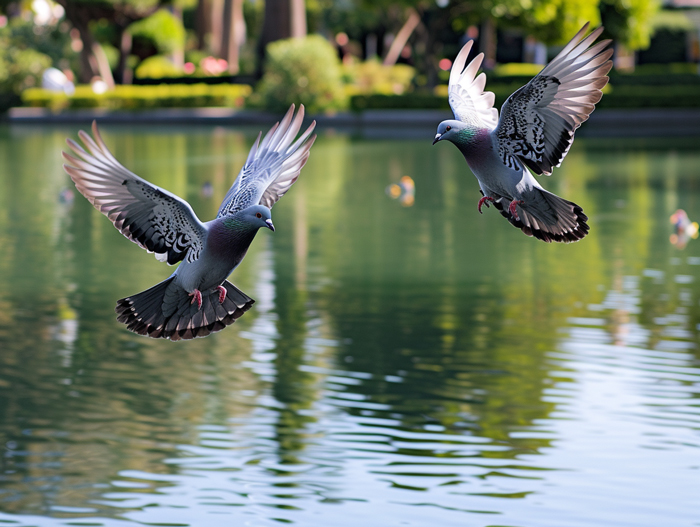
As a pigeon trainer, ensuring the health and safety of my feathered friends is of utmost importance. Here are a few key practices to keep your pigeons in top form:
1. Regular Veterinary Check-ups: Just like any other pet, pigeons require regular check-ups with a veterinarian who specializes in avian care. These professionals can provide valuable insight into the health of your pigeons and offer guidance on any necessary treatments or preventive measures.
2. Clean Living Environment: Providing a clean living environment is essential for the overall well-being of your pigeons. Regularly clean their coops or lofts, removing any droppings, old food, or debris. This helps prevent the spread of diseases and maintains a hygienic space for your pigeons to thrive.
3. Balanced and Nutritious Diet: Proper nutrition plays a vital role in keeping pigeons healthy and active. Ensure they have access to a balanced diet consisting of high-quality grains, seeds, and fresh fruits and vegetables. Additionally, consider including a pigeon vitamin supplement in their diet to fulfill any nutritional gaps.
4. Hydration is Key: Pigeons need access to fresh and clean water at all times. Drinking an adequate amount of water keeps them hydrated, aids digestion, and supports overall health. Regularly change the water and clean their drinking containers to prevent the growth of bacteria.
5. Parasite Prevention: Parasites can pose a significant threat to the health of your pigeons. Implement a regular parasite prevention program recommended by your avian veterinarian to protect your pigeons from external and internal parasites.
6. Exercise and Mental Stimulation: Just like humans, pigeons need exercise and mental stimulation to thrive. Provide them with enough flying time to keep their muscles strong and their minds engaged. Regular flying helps maintain their agility, builds endurance, and enhances their overall well-being.
Remember, maintaining the health and safety of your pigeons requires regular attention and care. By following these practices, you can ensure that your feathered friends are happy, healthy, and ready to soar to new heights in flying competitions.
The Thrill of Competing: Showcasing Pigeon Talent
Competing in flying competitions is where the true talent of pigeons shines. It’s an exhilarating experience for both the trainers and the audience. The competitive spirit of these events pushes the pigeons to showcase their incredible skills and abilities.
During these competitions, precision racing takes center stage. The pigeons are put to the test to see how fast, agile, and precise they can be. It’s a thrilling sight to watch as they navigate through the air, swooping and gliding with grace and accuracy.
Pigeons are true champions of the skies, with astonishing abilities:
- Speed: These feathered competitors can reach incredible speeds, making it an exciting challenge to see who can cross the finish line first.
- Agility: Pigeons possess remarkable maneuvering skills, effortlessly changing directions and adapting to various flight conditions. Their agility is truly remarkable.
- Precision: Precision racing requires pigeons to fly accurately through specific routes and checkpoints. The ability to hit these marks with precision showcases their exceptional navigational skills.
As a trainer, it’s a proud moment to witness your pigeons soar through the sky, showcasing their talents for everyone to see. The hard work and dedication put into their training pay off in these competitions.
Competing provides an opportunity to assess the progress made in training, identify areas for improvement, and gain recognition for the efforts put into shaping these remarkable birds. It’s also a great platform to learn from other trainers and exchange knowledge about training techniques.
The thrill of competing in flying competitions motivates trainers to continually refine their training methods and strive for excellence. It’s an ongoing process of pushing boundaries and unlocking the full potential of each pigeon. Knowing that your pigeons are competing against the best and standing a chance to come out on top adds an extra level of excitement and motivation.
In the next section, I’ll discuss the importance of maintaining the health and well-being of pigeons to ensure they are in top shape for these competitions.
Conclusion
In the world of pigeon training for flying competitions, precision racing is a key aspect that requires careful breeding and training techniques. By enhancing their speed, navigational skills, agility, and precision, pigeons can excel in these competitions. Acrobatic display training adds another dimension to their abilities, showcasing their aerial maneuvers.
Competing in flying competitions is a thrilling experience that allows us to witness the incredible talents of these pigeons. It serves as a constant motivation for trainers like myself to continually refine our training methods and strive for excellence. The dedication and passion we have for our pigeons drive us to push the boundaries of what they can achieve.
While the article has covered various aspects of pigeon training for flying competitions, it’s important to remember that maintaining the health and well-being of these birds is paramount. By providing them with proper care, nutrition, and a safe environment, we can ensure that they are in the best condition to perform at their highest level.
Pigeon training for flying competitions is a fascinating and rewarding endeavor. It requires a combination of skill, knowledge, and a deep connection with these remarkable birds. With the right approach and dedication, both pigeons and trainers can reach new heights in the world of flying competitions.

